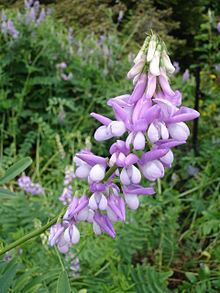 | ||
Similar | ||
The Inverted repeat-lacking clade is a monophyletic clade of the flowering plant subfamily Faboideae (or Papilionaceae) that includes the majority of agriculturally-cultivated legumes. It is characterized by the loss of one of the two 25-kb inverted repeats in the plastid genome that are found in most land plants. It is consistently resolved in molecular phylogenies. The clade is predicted to have diverged from the other legume lineages 39.0±2.4 million years ago (in the Eocene). It includes several large, temperate genera such as Astragalus , Hedysarum , Medicago , Oxytropis , Swainsona , and Trifolium .
Description
This clade is composed of five traditional tribes (Cicereae Alef. 1859, Fabeae Rchb. 1832, Galegeae Dumort. 1827, Hedysareae DC. 1825, Trifolieae Endl. 1830) and several genera of the traditional tribe Millettieae (Afgekia Craib 1927, Callerya Endl. 1843, Endosamara R. Geesink 1984, Sarcodum Lour. 1790, Wisteria Nutt.1818, and possibly Antheroporum Gagnep. 1915). The name of this clade is informal and is not assumed to have any particular taxonomic rank like the names authorized by the ICBN or the ICPN. The clade is defined as:
"The most inclusive crown clade exhibiting the structural mutation in the plastid genome (loss of one copy of the ~25-kb inverted repeat region) homologous with that found in Galega officinalis L. 1753, Glycyrrhiza lepidota Nuttall 1813, and Vicia faba L., where these taxa are extant species included in the crown clade defined by this name."
